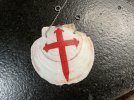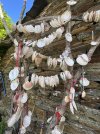JohnRRogers
New Member
- Time of past OR future Camino
- Camino Francis from SJPDP 12-5-23 / 17-6-23
For first timers, do you start wearing your scallop shell when you start the camino, or only after you have finished?
| Remove ads on the forum by becoming a donating member. More here. |
|---|
When you start. It identifies you as a pilgrim. In Medieval times the shell was given upon arrival in Santiago de Compostela, but now pilgrims receive the Compostela certificate instead.For first timers, do you start wearing your scallop shell when you start the camino, or only after you have finished?
I think in the olden times people wore them at the end. Now a scallop shell on your pack is a sign you are a pilgrim. Have seen them on new pilgrims starting out. FYI, my first one broke from banging around on stuff so careful how you attach it.For first timers, do you start wearing your scallop shell when you start the camino, or only after you have finished?
Actually I have been given a shell by locals. I have never paid for one for myself. They are not expensive though.I think in the olden times people wore them at the end. Now a scallop shell on your pack is a sign you are a pilgrim. Have seen them on new pilgrims starting out. FYI, my first one broke from banging around on stuff so careful how you attach it.
If you are starting in SJPdP shells are available at the Pilgrim's Office.Actually I have been given a shell by locals. I have never paid for one for myself. They are not expensive though.
I don't think we got one there. Sometime later someone gave me one as a gift. Mine broke, but I was given yet another. (Guess they wanted people to know I was a pilgrim.) Some people get them at a shell ceremony if they are American Pilgrims Chapter members.If you are starting in SJPdP shells are available at the Pilgrim's Office.
They keep Camino shells in a basket at the Pilgrims Office in SJPP. You chose one and give them a donation - I think it is €2. At least that’s what is was like many many years ago.I don't think we got one there
I know you do ‘tell it like it is’ but really - that happens?Some people get them at a shell ceremony if they are American Pilgrims Chapter members.
I was very surprised to learn about shell ceremonies a few years ago but apparently they are a big thing on the far side of the pond. An example here!I know you do ‘tell it like it is’ but really - that happens?

 www.musingsfromthelastfrontier.com
www.musingsfromthelastfrontier.com
Yes, it happens.I know you do ‘tell it like it is’ but really - that happens?
Yes, American Pilgrims Chapters have them and there is usually one at the annual Gathering meeting.Yes, it happens.
Modern pilgrims tend to wear their shells when they start, or as soon as they acquire them to identify themselves as pilgrims. There are some who believe that medieval pilgrims wore them after they finished, having received them in Galicia as they completed their Caminos.For first timers, do you start wearing your scallop shell when you start the camino, or only after you have finished?
It also happens in Canada. I was at the semi-annual general meeting of the Toronto Camino Community today and at each of these they have a ceremony where they give shells to those who intend to walk in the next six months. I got one that I will wear on my summer Camino.I know you do ‘tell it like it is’ but really - that happens?
Whereas I was given one in Roncesvalles on my first Camino at the same time as I was given my credencial and told to wear it. So I did, not super aware of the older tradition and ready to take their word on what to do.I did not carry a scallop shell on my first pilgrimage. I was aware of the older tradition that it was the badge of a pilgrim who had completed their pilgrimage to Santiago. I felt it was inappropriate and presumptuous for me to display one until I had visited the tomb of the Apostle. I have occasionally carried one on later journeys but I don't usually do so.
Hi all, I believe that the scallop shell has a few theories, like the "fingers" all end at the same point, symbolising the various camino routes all ending at SDC, or that the ancient pilgrims used it as a eating & drinking implement. It would be interesting to see the history & myths surrounding the shell.......either way, let the discussion begin.For first timers, do you start wearing your scallop shell when you start the camino, or only after you have finished?
I received mine at a shell ceremony yesterdayI don't think we got one there. Sometime later someone gave me one as a gift. Mine broke, but I was given yet another. (Guess they wanted people to know I was a pilgrim.) Some people get them at a shell ceremony if they are American Pilgrims Chapter members.
I have often read the suggestion that pilgrims used a scallop shell as a food bowl or drinking vessel on their journey. Occasionally with the added notion that the size of the shell was the food ration allowed per pilgrim by donors. But no one has ever been able to point me to any original source material to confirm this. Given the limited capacity of a scallop shell and its inconvenience for the purpose it strikes me as very unlikely. There is also a great deal of evidence of church regulations regarding the sale of scallop shells to pilgrims in Santiago. If pilgrims were already carrying their shells and using them as utensils along the Camino why would there be such a regulated market for them in the city?Hi all, I believe that the scallop shell has a few theories, like the "fingers" all end at the same point, symbolising the various camino routes all ending at SDC, or that the ancient pilgrims used it as a eating & drinking implement. It would be interesting to see the history & myths surrounding the shell.......either way, let the discussion begin.
Personally I have carried mine from the start....
If you want to buy one there are plenty of places which sell them. There is no standard practice of giving a shell to arriving pilgrims.Do they give you one when you finish, or do you buy one somewhere in Santiago?
I like this approach. I too, am not sure I want to display a shell until I feel I have earned it. I am making my first pilgrimage this year; I will leave the Frances at Leon and walk the San Salvador. I think that when I reach Oviedo, and earn my Salvadorana, I will attach my shell and wear it as I walk the Primitivo to Santiago. I am bringing my own scallop shell from the US; a smallish one I collected years ago that holds some memories.I did not carry a scallop shell on my first pilgrimage. I was aware of the older tradition that it was the badge of a pilgrim who had completed their pilgrimage to Santiago. I felt it was inappropriate and presumptuous for me to display one until I had visited the tomb of the Apostle. I have occasionally carried one on later journeys but I don't usually do so.
Every day’s a school day.Yes, it happens.
That was my thinking. I would no more have worn a shell on that first walk than I would have worn someone else's medals in the days when I wore military uniform. But clearly most people today see a very different meaning in the symbol and wear one in all good faith. Or do not wear one at all. A personal choice and significance.I like this approach. I too, am not sure I want to display a shell until I feel I have earned it.
Just a tip for those starting from Saint Jean Pied de Port. The local restaurants serving the essential French dish "Coquille St. Jacques" (James) usually supply all the scallop shells needed at the local Pilgrim Office on Rue de Citadelle. The staff bore holes and thread a simple cord, tying a knot.
I have observed that their supply peaks on Monday and dwindles towards Thursday / Friday until the dinner trade picks up for the weekend. Just an arcane point I suppose.
You can get them all up and down the Frances, from St Jean all the way to Santiago.Do they give you one when you finish, or do you buy one somewhere in Santiago?
If we are dealing in arcane detail about scallops here's an entertaining piece of trivia from the Wikipedia article about them: "Curiously the Linnaean name Pecten jacobeus is given to the Mediterranean scallop, while the scallop endemic to Galicia is called Pecten maximus due to its bigger size."Yes, an arcane point indeed, what with scallops being seasonal and everything..
It's a symbolic blessing for those starting out on their journey.I know you do ‘tell it like it is’ but really - that happens?
Any time you want. There are no dos or donts. In medieval times pilgrims wore them upon completion and wore them home. Some then wore them for the rest of their lives. However back then they were only available at the end. Now, you wear it with pride anytime you wantFor first timers, do you start wearing your scallop shell when you start the camino, or only after you have finished?
I wonder what tradition this might have been? I don't recall there being a beach at Santiago, presumably the end of the journey for pilgrims on the Camino de Santiago. Would they have been more likely to have a meal of scallops in Santiago and retain a shell from that than walking out to the coast at Muxia or Finisterre? If not that way, I can imagine local traders having a ready supply of these collected in bulk from local eating establishments, cleaned up and then adorned with the St James cross or other religious motifs.I wanted to honor the tradition of finding a shell on the beach to mark the end of my Camino when I got to Fisterra so I didn't buy one before I set out on my walk last spring. Instead, I bought a small patch from Ivar's Camino shop and attached that to my backpack to identify myself as a pilgrim. (It's this one, which is currently out of stock.)
For first timers, do you start wearing your scallop shell when you start the camino, or only after you have finished?



For first timers, do you start wearing your scallop shell when you start the camino, or only after you have finished?
You can buy them almost anywhere along the way. That right place, well, that will be up to u.Do they give you one when you finish, or do you buy one somewhere in Santiago?
Leo looks very soft in that first photo. He is beautiful.I've always worn a pilgrim shell on my hat, with another on my horse Leo's browband. My sister Susie did the same when we rode together from Canterbury to Santiago (the middle photo shows Leo and me talking to tourists at Vézelay), and when I rode alone to Rome some years later. Leo sneezed all over the police officer in the photo outside St Peter's, but he (the officer!) managed to continue smiling ... The shell opened a lot of doors (including stable doors) not to mention garden gates courtesy of helpful people who were very pleased to have their lawns mown overnight.
Every day’s a school day.
It sounds splendid, but perhaps is another example of the cultural divide between the UK and other anglophone cultures.
In general; we’re not very ‘clubable’ and faintly embarrassed to admit we belong to anything. (With the exception of oxbridge graduates, vegans* and wild-swimmers who will declare themselves to a bus-queue if there’s no one else within earshot)
* no offence intended. It is, however, true where I come from.

On the Groucho Marx principle?Clubs of every form are 'de rigueur' down under.
Not that I would admit to being a member of any of course.........
I have one from him too, which I wear often even when not on Camino.I wear mine around my neck. It's a small iron one I bought at the blacksmith who has a place near the wine fountain at Irache.
If local-sourced and harvested scallops are indeed 'seasonal,' how does Coquille St. Jacques remain on the menu year-round? Regardless of where they are sourced, those at SJPdP go from restaurant kitchen to the local Pilgrim Office. That is good enough for me.Yes, an arcane point indeed, what with scallops being seasonal and everything..
..and from what I understand, fishing of la coquille Saint Jacques is severely reglemented and controlled in France and that the season is roughly from October to April. However, in the maritime area close to SJPP, it was restricted to 2-28 December 2022 this time round.
So, your observations of the ebbing and flowing of locally sourced scallop shells in SJPDP would have been made during a winter camino?
Wish I'd known! I leave for Camino #6 in three weeks. The Toronto Camino Community is likely the closest to my home in St. Catharines, and it would have been nice to connect with pilgrims and participate in the shell ceremony. (Or at least observe.)It also happens in Canada. I was at the semi-annual general meeting of the Toronto Camino Community today and at each of these they have a ceremony where they give shells to those who intend to walk in the next six months. I got one that I will wear on my summer Camino.
I picked up my shell in the pilgrim's office in SJPDP. It serves a usefull purpose. It's clatter when attached to a backpack and sight warns other to stay away or I will bore you with my insistent Camino blabbing.For first timers, do you start wearing your scallop shell when you start the camino, or only after you have finished?
It's possible thanks to frozen imports from around the world of bivalves that can be commercialised, due to a WTO decision in the 1990s, as "Saint Jacques" in France even when they are not even the real Pecten maximus. From https://www.regal.fr/recettes/poissons-crustaces-et-fruits-de-mer/saint-jacques-ou-petoncles-17969 (translated):If local-sourced and harvested scallops are indeed 'seasonal,' how does Coquille St. Jacques remain on the menu year-round?
Fear not, there is a Camino event happening this weekend (March 11th) in Hamilton (even closer to St. Catharines, I believe), so all is not lost.Wish I'd known! I leave for Camino #6 in three weeks. The Toronto Camino Community is likely the closest to my home in St. Catharines, and it would have been nice to connect with pilgrims and participate in the shell ceremony. (Or at least observe.)
That's marketing for you, don't be taken in by everything you see advertised on a menu. In season sure, probably what it says.. but out of season and in summer?If local-sourced and harvested scallops are indeed 'seasonal,' how does Coquille St. Jacques remain on the menu year-round?
I was referring to the tradition espoused by some that the scallop shell was originally something pilgrims acquired at the end of their journey, whether in Santiago or (in my case) Fisterra. But thanks for the helpful reminder that there’s no beach in Santiago.I wonder what tradition this might have been? I don't recall there being a beach at Santiago, presumably the end of the journey for pilgrims on the Camino de Santiago. Would they have been more likely to have a meal of scallops in Santiago and retain a shell from that than walking out to the coast at Muxia or Finisterre? If not that way, I can imagine local traders having a ready supply of these collected in bulk from local eating establishments, cleaned up and then adorned with the St James cross or other religious motifs.
But thanks for the helpful reminder that there’s no beach in Santiago.



I'm not sure how much of that is myth.I didn't realise the original idea was that you put it on at the end.
The pilgrim's meal with "Saint James scallops" that I had was in a pilgrim albergue-restaurant in Fromista on the Camino Frances in Spain. It was very similar to this product shown in the photo below which is sold in France and where the final place of 'production' is in the Bretagne (!).how I wish that I had known this before I once ordered a pilgrim's menu that promised "Saint James scallops" as the first course. They were a very far cry from what I had expected ... from the look of them, they must have been the tiny Argentinian ones.

Very interested, and Hamilton is much closer. Less time in QEW traffic, too. Thank you for this.Fear not, there is a Camino event happening this weekend (March 11th) in Hamilton (even closer to St. Catharines, I believe), so all is not lost.
Doors open at 8:30; program starts at 9am.
First Unitarian Church, 170 Dundurn St. South, Hamilton
This will be a half day aimed at fellowship, talks and information to help you on your WAY.
They'll have a series of 10-minute 'Tapestry Talks', a CCoP booth, a hospitalero info booth, a session on a typical day on the Camino and plenty of time to meet friends and make new ones.
If you want more information, I can put you in touch with one of the organizers. I don't know if they will be having a shell ceremony but if not, they might be willing to provide one.
I got mine from Pablo Payo, El Mesonero Mayor del Camino de Santiago, at Villalcázar de Sirga, on my Way to Santiago in 1994.I've brought mine back from SdC, like in the old days.
Yip, I know that since the middle ages there would be some "cheaters", that didn't made it to SdC and brought back a shell.
Yes, I've seen that blacksmith on a few vlogs. That's the one for me.I wear mine around my neck. It's a small iron one I bought at the blacksmith who has a place near the wine fountain at Irache.
It would be interesting to see his work. How can I view his videos?Yes, I've seen that blacksmith on a few vlogs. That's the one for me.
On YouTube: Camino Frances 2022 Day 6 Michael Matthias.It would be interesting to see his work. How can I view his videos?
So they are at the Albergues Jesus y Maria and Casa Paderbornin Pamplona and in many other alternative starting points.If you are starting in SJPdP shells are available at the Pilgrim's Office.
You can also buy them in supermarkets. Eat th scallops and keep the shells. I have about a dozen of them at home. I also got a couple in a restaurant that served scallops in the shell. Unfortunately, my attempts to draw a cross on them was not highly successful. My best attempt was with an indelible marker which wore off by the time I got halfway to Santiago. I think I may have been breaching copyright though as I read somewhere that the Cathedral authorities have exclusive rights on all shells with crosses soldYou can buy them almost anywhere along the way. That right place, well, that will be up to u.
That was what I did as well. Now I wear it all the time and it has started many conversations.I did not carry a scallop shell on my first pilgrimage. I was aware of the older tradition that it was the badge of a pilgrim who had completed their pilgrimage to Santiago. I felt it was inappropriate and presumptuous for me to display one until I had visited the tomb of the Apostle. I have occasionally carried one on later journeys but I don't usually do so.
I'am a chef in a restaurant and we would buy them by the case. I brought 5 scallop shells home from work that was thinking of bringing one for my camino in May, but decided no. I laughed about the cross but I decided not to even try.You can also buy them in supermarkets. Eat th scallops and keep the shells. I have about a dozen of them at home. I also got a couple in a restaurant that served scallops in the shell. Unfortunately, my attempts to draw a cross on them was not highly successful. My best attempt was with an indelible marker which wore off by the time I got halfway to Santiago. I think I may have been breaching copyright though as I read somewhere that the Cathedral authorities have exclusive rights on all shells with crosses sold
Now that is odd but funny.Because of family trauma many years ago, I cannot bring myself to wear or otherwise sport a scallop shell. 76 years next week my parents went out to dinner, I guess because they were expecting their second child to be born a few days later. My mother ordered scallops, enjoyed them but became violently ill when she got home. They went to the hospital emergency room, and I was born a very short time later. To the end of her days my mother would never eat scallops again, explaining, "Look what happened last time," pointing to me.
And I thought it was all about storks! Now I know.To the end of her days my mother would never eat scallops again, explaining, "Look what happened last time," pointing to me.
If it was all about storks there are a lot of Camino villages that would be a lot more populated!And I thought it was all about storks! Now I know.
Ha! This caught my interestThis same church (St.Leonhards) underwent extensive archeology the past 15 years and on the original level, they found an altar dating from the early 1200's with piles of scallop shells next to it.

I must try to visit at least St Leonhard's if and when I pass through Frankfurt. Just seeing the photo of this church with the whitewashed walls and the red Main sandstone makes me already nostalgic ...Yep, i have that book because I do tours in this church, plus we walk by it on our Daily tours in Frankfurt. One other Camino church would be the Justinus church in Frankfurt Höchst. It is another traditional stop on the Main.
He was very beautiful. Sadly he died in the summer of 2021 (aged 28, so a good age, but it was no consolation!) and I still miss him every day. He'd been a successful show horse before I bought him as a six year old, and I don't think he had our initial 1700 mile trek to Santiago in mind at all, but he became completely hooked on long distance travel - as did I, needless to say. Pilgrimages in particular.Leo looks very soft in that first photo. He is beautiful.
I will second that…I got my shell that way. It was an emotional moment for me!Yes, it happens.
Indeed! I’ve had some good conversations in airport terminals with people who’ve had a shell on their pack.On my pack from the day I board the plane. You might meet a fellow pilgrim that way.
I don't think it is instead. It is in addition to. I think in the Medieval times they had it right. You had to earn it so you got your shell when you arrived in Santiago de Compostela. Just my opinionWhen you start. It identifies you as a pilgrim. In Medieval times the shell was given upon arrival in Santiago de Compostela, but now pilgrims receive the Compostela certificate instead.
I agree completely and did not get mine until I arrived in Santiago.I did not carry a scallop shell on my first pilgrimage. I was aware of the older tradition that it was the badge of a pilgrim who had completed their pilgrimage to Santiago. I felt it was inappropriate and presumptuous for me to display one until I had visited the tomb of the Apostle. I have occasionally carried one on later journeys but I don't usually do so.
Sounds like a very nice tradition for you.Before walking a Camino, I get a scallop shell of a beach here in New Zealand and fix it to my pack. When I get to Finesterre I throw it into the sea. This is nothing to do with tradition or whatever. For me it just marks the start and finish of my Camino. After throwing my shell into the sea I pick up a small stone to bring back home which I put with other stones I have collected from around the world as momentos.


